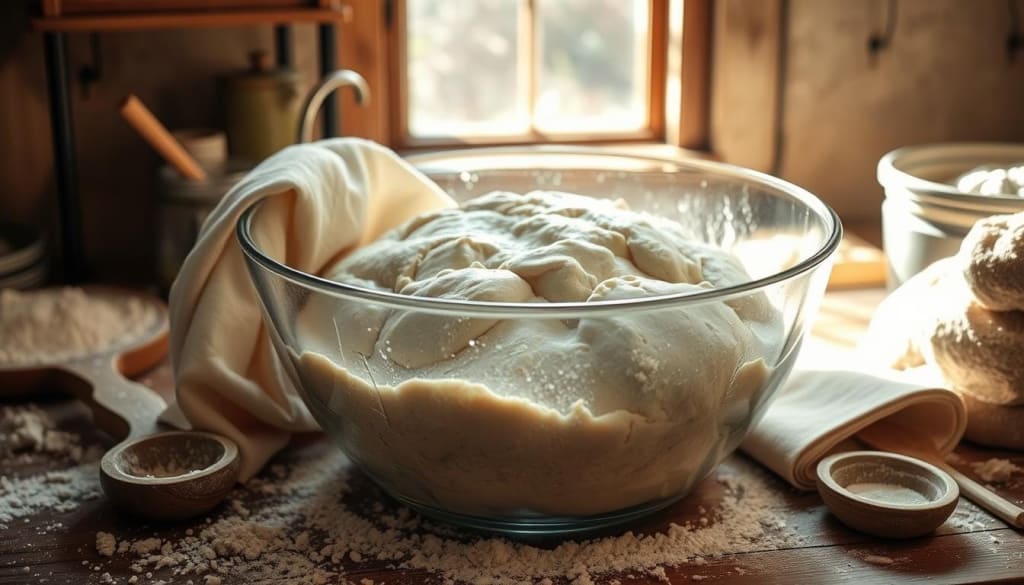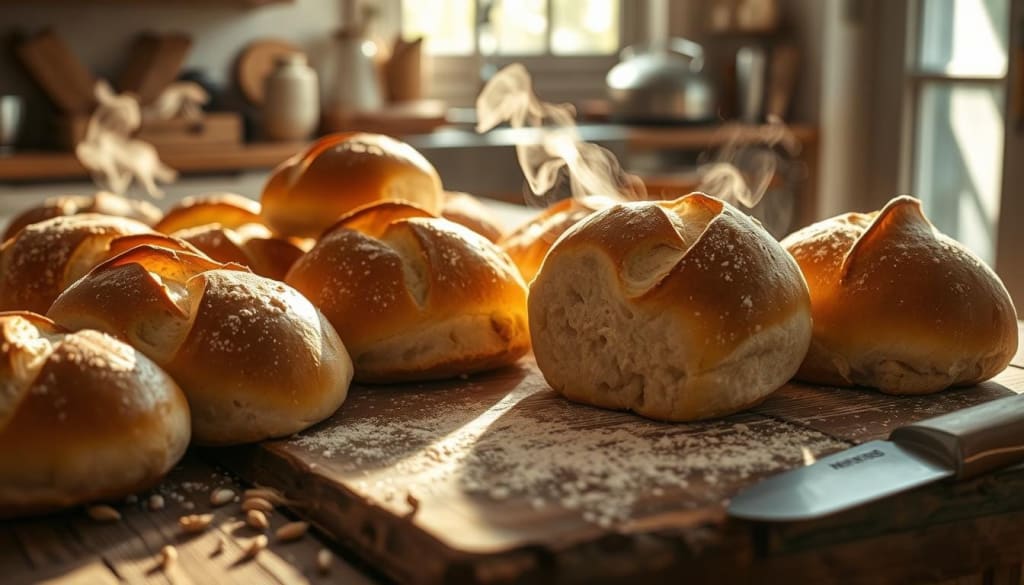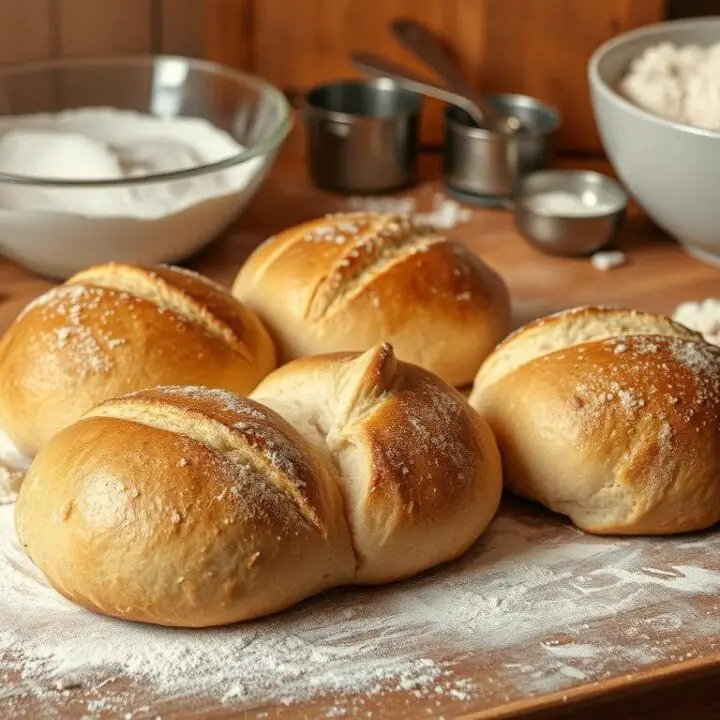As a seasoned home baker, I love the joy of biting into a warm, soft sourdough roll. The tangy taste, golden crust, and soft texture are unmatched. It feels like stepping into a cozy farmhouse kitchen. That’s why I’m excited to share my favorite sourdough rolls recipe with you.
Key Takeaways
- Sourdough rolls recipe featuring a bubbly, active sourdough starter
- Soft, fluffy, and buttery texture with a signature sourdough tang
- Easy-to-follow instructions for mixing, fermenting, shaping, and baking
- Ideal accompaniment to any meal, perfect for holidays and gatherings
- Recipe yields 12-15 rolls, with nutritional information provided
Soft and Fluffy Sourdough Dinner Rolls
Making soft and fluffy sourdough dinner rolls at home is rewarding. It lets you enjoy the unique flavors and textures of artisan bread. This recipe needs just a few ingredients and patience, but the results are worth it.
Ingredients and Equipment Needed
- 1 cup (240g) warm milk
- 4 Tablespoons (54g) melted butter
- 1 cup (200g) active sourdough starter
- 2 Tablespoons (24g) sugar
- 1 egg
- 3 3/4 cups (470g) bread flour
- 1 1/2 tsp (9g) salt
- 9×13 inch glass baking dish
This recipe makes 12 rolls at 80g each or 18 rolls at 50g. You can also make 6 larger rolls for burger buns. A stand mixer makes mixing the dough easy, but you can also knead it by hand.
Step-by-Step Instructions
- In a small saucepan, melt the butter and mix it with warm milk, sugar, and salt. Let it cool to lukewarm.
- In a large mixing bowl, mix the lukewarm milk mixture, sourdough starter, and egg until well combined.
- Add the bread flour and knead the dough. You can do this by hand or with a stand mixer. Knead until it’s smooth and elastic, about 10 minutes.
- Cover the dough and let it bulk ferment for 2-3 hours. Do 3 sets of stretch and folds during this time.
- Divide the dough into equal pieces and shape into rolls. Place the rolls in the prepared baking dish and let them proof for 1-2 hours.
- Bake the sourdough dinner rolls at 350°F (180°C) for about 30 minutes, until golden brown. The internal temperature should be 190°F (88°C).
With the right technique and practice, you can make homemade sourdough dinner rolls. The step-by-step instructions help you create these artisan-style rolls easily at home.
Benefits of Sourdough Bread
Sourdough bread is more than just a tasty treat. It has several health benefits over regular yeast-based bread. The fermentation process breaks down grains, making nutrients more available and the bread easier to digest.
One big plus of sourdough is its lower glycemic index. This means it has less effect on your blood sugar. It’s a better choice for those who need to keep their glucose levels in check. The long fermentation also reduces gluten, helping those with gluten sensitivities.
- Sourdough bread is more digestible and nutrient-dense due to the fermentation process.
- The long fermentation helps break down gluten, making sourdough a better option for those with gluten sensitivities.
- Sourdough has a lower glycemic index, meaning it won’t spike your blood sugar levels as much as regular bread.
- The fermentation process may also enhance the antioxidant content and prebiotic properties of sourdough bread, supporting gut health.
The health benefits of sourdough can vary. This depends on the type of microbes, fermentation conditions, and flour used. Still, adding sourdough to your diet can be a smart choice for your health. It’s a delicious and nutritious addition to your meals.
“Sourdough bread is a nutritious and satisfying choice that can offer a range of health benefits, from improved digestion to better blood sugar management.”
Tips for Making Perfect Sourdough Rolls
Making sourdough rolls needs attention to temperature and the baking dish. The recipe works best in a kitchen at 68°F (20°C). If it’s warmer, you’ll need to shorten the rising times to avoid over-proofing.
In cooler kitchens, you’ll need to let the dough ferment and proof longer. It’s important to watch the dough’s temperature and adjust the times to get the rolls just right.
Maintaining the Right Temperature
Temperature affects sourdough fermentation and proofing a lot. The recipe suggests a kitchen temperature of 68°F (20°C) for the best conditions. If it’s warmer, you might need to shorten the rising times.
On the other hand, if it’s cooler, you’ll need to let the dough ferment and proof longer. This ensures the dough rises and gets the right texture.
Choosing the Right Baking Dish
For the softest rolls, use a glass baking dish. Glass distributes heat evenly, making the rolls tender and golden. If you use a metal tin, like a 9×13 inch pan, bake at 400°F (204°C) for 22-25 minutes.
This prevents the rolls from getting too brown or dry. Always check the rolls to avoid over-baking.
| Baking Dish | Temperature | Baking Time |
|---|---|---|
| Glass Baking Dish | 375°F (190°C) | 25-30 minutes |
| Metal Baking Tin (9×13 inch) | 400°F (204°C) | 22-25 minutes |
“Maintaining the right temperature and choosing the appropriate baking dish are critical factors in achieving perfectly baked sourdough rolls.”
Sourdough Rolls Recipe
Take your baking to the next level with this sourdough rolls recipe. These rolls are fluffy and golden, showing off the skill of artisan bread making. Whether you’re a sourdough pro or just starting, this recipe will help you make homemade sourdough rolls that wow everyone.
To start, you’ll make a levain. It’s the base of your rolls. Mix 7 grams of ripe starter, 70 grams of warm water, and 70 grams of bread flour. Let it ferment for 10-12 hours at 78-80°F. This makes a bubbly starter that adds flavor to your dough.
Then, mix the dough ingredients. You’ll need 235 grams of whole milk, 25 grams of sugar, 35 grams of butter, 12 grams of salt, 25 grams of cornstarch, and 3-4 cups of bread flour. The dough will ferment for about 4 hours. You’ll also do stretch and fold techniques to improve its texture and taste.
After fermenting, shape the dough into 12 equal parts. Let them proof for 3-4 hours at 80-85°F. This makes them double in size, giving them a light texture.
Finally, bake the rolls at 350°F for about 30 minutes. They should reach 190-195°F inside. This will give them a golden crust and a soft inside that everyone will love.
These sourdough rolls are perfect for any occasion. They offer a great mix of tangy and sweet flavors. Enjoy the joy of making artisan bread baking at home.
Feeding Your Sourdough Starter
To make the perfect sourdough rolls, you need an active starter. Feed your starter the night before. The recipe requires 1/2 cup (100g) of starter, so let’s get it ready.
Creating an Active Bubbly Starter
Start by adding 1 tablespoon (15g) of ripe starter to a clean jar. Mix in 1/3 cup + 1 tablespoon (50g) of flour and 3 1/2 tablespoons (50g) of water. Stir until everything is well combined.
Cover the jar loosely and let it rise at room temperature for 10-12 hours. It should double in size and be full of bubbles.
Keeping your starter healthy is key for great sourdough. Feed it twice a day at room temperature. Store it in the fridge to feed it once a week. After each fridge feeding, let it rest at room temperature for at least 2 hours before putting it back in the fridge.
When your starter is ready for baking, it should have doubled or tripled in 6 to 8 hours. The final feeding should leave enough starter for the recipe and to keep it alive for the next time.
Remember, you can use discarded starter to make treats like pancakes, waffles, cake, pizza, and flatbread. Sourdough baking lets you choose how to keep your starter, based on what works best for you.
By following a consistent process and watching for signs of an active starter, you’ll make perfect sourdough rolls. Stay tuned for the next steps in the recipe!
Mixing the Dough
Making perfect sourdough rolls begins with mixing the dough carefully. Start by mixing your active sourdough starter with warm milk, sugar, melted butter, salt, cornstarch, and flour. If you have a stand mixer, knead for 5-8 minutes until it’s smooth but not too sticky. If kneading by hand, do it for 10-12 minutes until it’s elastic.
The secret to great sourdough dough mixing is finding the right balance. Kneading well helps the dough rise beautifully. Make sure the dough is in a warm 78-80°F place to help it ferment.
- Combine the active sourdough starter (200g), warm milk (75g), sugar (65g), melted and cooled butter (57g), salt (10g), and bread flour (450g) in a large mixing bowl.
- If using a stand mixer, knead the dough for 5-8 minutes until it becomes smooth and tacky, but not overly sticky.
- For hand-kneading, work the dough for 10-12 minutes until it passes the windowpane test, indicating a well-developed gluten structure.
- Once the dough is properly mixed and kneaded, place it in a lightly oiled bowl and cover it in a warm 78-80°F environment to begin the bulk fermentation process.
“The secret to exceptional sourdough rolls lies in the perfect balance of artisan bread baking techniques and the natural fermentation process.”
By carefully mixing the sourdough dough, you’re setting the stage for a delicious result. Next, we’ll explore the bulk fermentation process.
Bulk Fermentation and Stretch and Folds
During the 4-hour sourdough bulk fermentation period, the dough goes through 3 sourdough stretch and fold sessions. These are spaced 30 minutes apart. This process is key for developing the dough’s gluten structure and making it strong. It’s essential for getting the right texture in your artisan bread baking.
After the last stretch and fold, the dough is covered and continues to ferment. It’s ready when it’s about 50% bigger. Keeping the temperature between 78-80°F is important for proper sourdough bulk fermentation.
- Do the first set of stretch and folds 30 minutes after mixing.
- Repeat the stretch and fold two more times, each 30 minutes apart.
- Cover the dough and let it ferment for the next 3 hours.
- Check the dough’s volume, which should be about 50% bigger during bulk fermentation.
| Metric | Value |
|---|---|
| Total Dough Weight | 1200 grams |
| Pre-fermented Flour | 12.5% |
| Levain in Final Dough | 37.1% |
| Hydration | 43.0% |
| Yield | 16 x 70g sourdough dinner rolls |
In nearly every sourdough bread recipe, there is at least one set of stretch and folds during bulk fermentation.

The dough gets stronger during sourdough bulk fermentation. It moves from weak to strong. Most dough recipes need three sets of sourdough stretch and folds. Adjustments depend on the dough’s initial strength. The dough is ready to rest for the rest of the bulk fermentation without more intervention.
Shaping and Proofing the Rolls
After the dough finishes its bulk fermentation, it’s time to shape and proof the sourdough rolls. This step is key to the final texture and look of your artisan bread.
Start by turning the dough out onto a lightly floured surface. Divide the dough into 12 equal pieces, each about 65g. Shape each piece into a smooth, round ball by gathering the sides and pinching them together at the bottom.
- Place the shaped rolls into a lightly greased 9×13 inch baking dish, spacing them evenly apart.
- Cover the dish with a clean, damp towel or plastic wrap. Let the rolls proof at room temperature for 3-4 hours, or until they double in size and feel light and airy.
During proofing, the rolls will rise and get soft and fluffy. It’s important to let them proof enough. This ensures the perfect crumb structure and rise in the oven.
Remember, your kitchen’s temperature and humidity can change proofing time. Keep an eye on the rolls and adjust the time if needed. With practice, you’ll get perfectly proofed sourdough rolls every time.
Baking Sourdough Rolls Recipe
Baking the perfect sourdough rolls is the final step. To get the ideal crust, preheat your oven to 375°F (190°C) about 20 minutes before. This ensures your oven is ready for baking.
Once your oven is ready, place the proofed rolls on a baking sheet or in a 9×9 inch baking dish. Bake for 25-30 minutes. The tops should be golden brown and the inside should be 190°F (88°C).
To get a shiny crust, brush the rolls with melted butter right after baking. This step adds flavor and makes your bread look great.
Whether baked on a sheet or in a dish, your sourdough rolls will be soft and perfect. They’re great with soups, stews, or your favorite baking sourdough rolls dish. Enjoy your sourdough baking success!

Storing and Freezing Sourdough Rolls
Keeping your homemade sourdough rolls fresh and flavorful is key. There are great ways to store and freeze them. This way, you can enjoy them for days or weeks.
Storing Sourdough Rolls at Room Temperature
Store fresh sourdough rolls at room temperature. Use a bread bag or a clean tea towel for up to 3 days. This keeps them soft and aromatic.
Freezing Sourdough Rolls
To store them longer, freeze your sourdough rolls. Put them in a freezer-safe bag or container. Store in the freezer for up to 3 months. Reheat in the oven until warm and crusty.
Freezing right is important. Cool the rolls completely before freezing. Flash-freezing individual rolls makes them easier to access.
Reviving Frozen Sourdough Rolls
To enjoy frozen rolls, preheat your oven to 300°F (150°C). Place the frozen rolls on the oven rack. Bake for 10-15 minutes until warm and crispy.
Follow these tips to keep your sourdough rolls fresh longer. Enjoy them anytime, without losing their quality or taste.
Conclusion
The sourdough rolls recipe in this article is a must-try for anyone who loves baking artisan bread. These rolls offer a soft, fluffy texture and a tangy sourdough flavor. They are perfect for any meal.
Whether you’re experienced in sourdough baking or just starting, the detailed instructions and tips will help you. You’ll learn how to maintain the right temperature and shape the rolls to perfection. This ensures you get excellent results every time.
Every step of the recipe is designed to help you make the ultimate sourdough dinner rolls. With a high social media sharing rate and a stellar rating, many home bakers have already fallen in love with this recipe.
So, what are you waiting for? Start baking sourdough bread and make these delicious sourdough rolls for your family and friends. They’re great with a hearty meal or enjoyed on their own. These homemade treats will quickly become a favorite in your home.

Sourdough Rolls Recipe
Soft, tangy sourdough dinner rolls that combine the complex flavors of wild yeast with the comfort of traditional dinner rolls. Perfect for any meal.
Ingredients
- 1 cup sourdough starter
- 1 cup warm water
- 4 cups all-purpose flour
- 1 tbsp sugar
- 2 tsp salt
- 2 tbsp olive oil
Instructions
- In a large bowl, combine the sourdough starter, water, and flour. Mix until a dough forms.
- Knead the dough on a floured surface for 10 minutes.
- Place the dough in a greased bowl, cover, and let rise for 4-6 hours or until doubled in size.
- Punch down the dough and divide it into 12 pieces.
- Shape each piece into a roll and place on a baking sheet.
- Cover and let rise for another 1-2 hours.
- Preheat oven to 375°F (190°C).
- Bake the rolls for 20 minutes or until golden brown.
- Let cool before serving.
Nutrition Information:
Yield: 12 Serving Size: 1Amount Per Serving: Calories: 212Total Fat: 3gSaturated Fat: 0gTrans Fat: 0gUnsaturated Fat: 2gCholesterol: 0mgSodium: 390mgCarbohydrates: 40gFiber: 2gSugar: 1gProtein: 6g
FAQ
What are the key ingredients needed to make sourdough rolls?
To make sourdough rolls, you need active sourdough starter, whole milk, and sugar. Also, unsalted butter, salt, cornstarch, and bread flour are essential. Don’t forget a 9×13 inch glass baking dish.
What are the steps for making the sourdough rolls?
First, mix the levain the night before. Then, mix the dough. Next, do stretch and folds during bulk fermentation.
Shape the rolls, proof them, and bake until golden brown.
What are the benefits of sourdough bread compared to regular yeast bread?
Sourdough bread has more nutrients and a lower glycemic index. It might also have less gluten, which is good for some people.
How important is maintaining the right temperature when working with sourdough?
The right temperature is key for perfect sourdough rolls. The recipe is tested at 68°F. Adjust rising times if your kitchen is warmer or colder.
What’s the best baking dish to use for sourdough rolls?
Use a 9×13 inch glass baking dish for the softest rolls. A 9×9 inch metal tin works too, but bake at a higher temperature for a shorter time.
How do you prepare the sourdough starter for this recipe?
Feed the starter the night before. Use 1 tablespoon of ripe starter, 1/3 cup + 1 tablespoon of flour, and 3 1/2 tablespoons of water. Let it rise for 10-12 hours until it’s doubled and bubbly.
How do you store and freeze the baked sourdough rolls?
Store baked rolls at room temperature in a bread bag or wrapped in a tea towel for up to 3 days. Freeze them for up to 3 months in a freezer-safe bag for longer storage.






